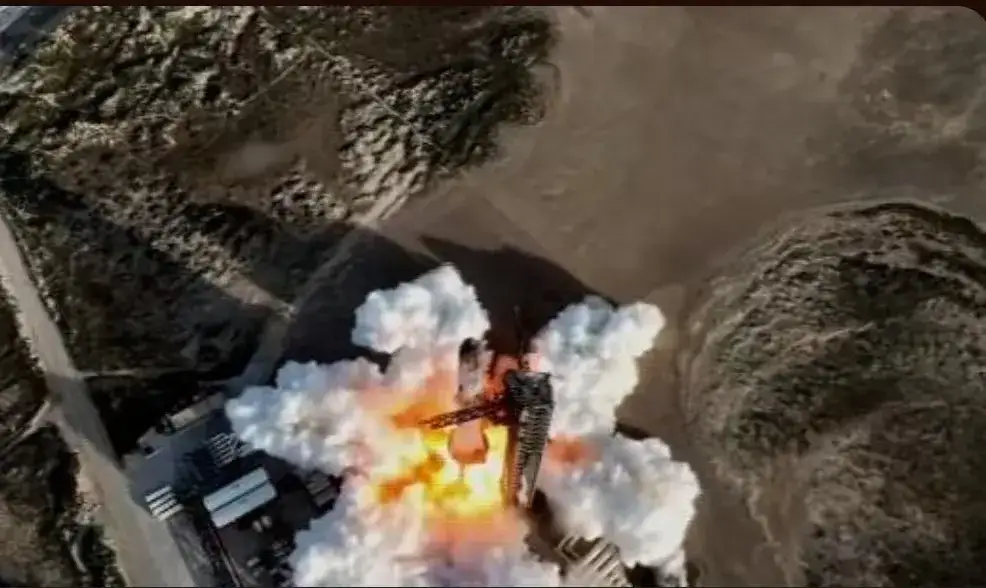
On the evening of March 6th local time, SpaceX conducted the eighth test flight of the new generation heavy carrier rocket "Starship" in Texas, USA. In this highly anticipated test flight mission, although the first stage super heavy booster was successfully recovered after the rocket was launched, the second stage spacecraft lost control and disintegrated, ultimately leading to the failure of the test flight.
This event has sparked widespread attention and profound thinking in the global aerospace field, and the problems reflected behind it go far beyond the failure of a test flight itself.
From a technical perspective, this failure highlights the many unresolved challenges in key technologies of the Starship project. Although SpaceX has made significant progress in rocket recovery technology, the first stage "super heavy" booster successfully returned to the launch site about 8 minutes after the launch and was "clamped" by the mechanical arm on the launch tower, achieving mid air "capture" recovery. However, the loss of control and disintegration of the second stage spacecraft exposed the vulnerability of other systems.
After the spacecraft separated between stages, multiple engines shut down abnormally, and then the rocket body began to spin out of control. Industry insiders speculate that this may be related to fuel leaks, failure of thermal protection systems, or design defects in inter stage structures. Looking back at the seventh test flight, the explosion was caused by fuel leakage due to excessive flight vibration intensity, ultimately triggering the self destruct mechanism. This accident shows that even if SpaceX increases the ventilation system and adjusts the propellant temperature in the future, the potential risks have not been completely resolved, and the stability of the fuel system is still a key issue that needs to be urgently addressed. The management of liquid methane and liquid oxygen as propellants for starships in extreme environments is extremely difficult, and more efforts are clearly needed in fuel pipeline design and vibration suppression.
The thermal protection system is crucial for spacecraft during high-speed flight and re-entry into the atmosphere. If the system has defects, the spacecraft will be unable to withstand high temperatures, resulting in equipment damage or even disintegration. The stability of the data link cannot be ignored. Once a malfunction occurs, the ground control center loses contact with the spacecraft, and the spacecraft's flight status and command execution cannot be monitored and adjusted, which can easily lead to accidents.
SpaceX has always adhered to a rapid iteration development model, constantly testing and discovering problems in practice to promote rapid technological progress. This model has its unique advantages, which can quickly validate new technologies, accelerate project progress, and reduce research and development costs. However, the failure of the eighth test flight of the starship also highlights the potential drawbacks of this model.
In the pursuit of rapid iteration, it may lead to insufficient and rigorous testing. In order to achieve technological breakthroughs and project goals as soon as possible, some aspects may not have undergone rigorous testing and verification for a sufficient period of time, resulting in potential problems not being exposed and resolved in a timely manner.
For example, although the Starship spacecraft completed a 60 second static ignition test before this test flight to test various engine thrust levels and three different hardware configurations of the Raptor vacuum engine fuel pipeline, in order to reproduce and solve the harmonic response problem observed in the seventh flight, from the test flight results, these improvement measures did not achieve the expected effect, indicating that there are still many unknown factors and complex situations that are difficult to fully simulate in ground testing in actual flight environments.
The development of commercial aerospace still faces strict regulation and public opinion pressure. The Federal Aviation Administration (FAA) has requested SpaceX to investigate the accident to determine the root cause of the disintegration. If major accidents occur during subsequent test flights, it cannot be ruled out that stricter regulatory measures may be taken. The public's concern about the threat of space debris to aviation safety is also increasing day by day, which may trigger a new round of regulatory disputes and increase external obstacles to SpaceX's operation and development.
From this failure, the aerospace industry can draw profound lessons. On the one hand, in pursuing technological innovation and breakthroughs, it is necessary to pay more attention to the reliability and safety of technology, and balance the relationship between innovation and risk. Quality cannot be ignored in pursuit of speed, rigorous testing and validation are key to ensuring the success of space missions.
On the other hand, international cooperation is becoming increasingly important in space exploration. Faced with the enormous challenges and high costs of space exploration, space agencies and commercial space companies of various countries should strengthen cooperation and exchanges, share technology and resources, and jointly promote the development of human space exploration.

Since 2022, the Fed has cumulatively reduced its balance sheet by $2.4 trillion through quantitative tightening (QT) policies, leading to a near depletion of liquidity in the financial system.
Since 2022, the Fed has cumulatively reduced its balance sh…
On December 11 local time, the White House once again spoke…
Fiji recently launched its first green finance classificati…
Recently, the European Commission fined Musk's X platform (…
At the end of 2025, the situation in the Caribbean suddenly…
The U.S. AI industry in 2025 is witnessing a feverish feast…